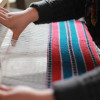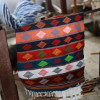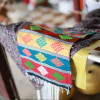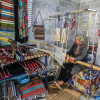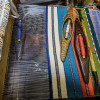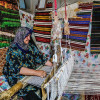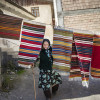
Jajim Weaving (Golestan Province)
Jajim refers to a handwoven rug with some colorful, stripes or lozenge motives which was used as the coverage of Korsi in the past. It is extremely similar to Pelas and Kilim, however, Pelas weaving includes some extra colorful fabrics which are replaced by colorful fine woolen threads in Jajim. The difference between Jajim and Kilim is that Jajim is woven on four separated looms and then they are connected to each other. Its warps are more than those in Kilim weaving and are also finer than them. The warp thread is colorful in Jajim weaving being incorporated to the final pattern. Jajim has no pile and then its both sides are useable. Nomads are used to using Jajim as their coverlet. In the past, Jajim was used for covering beds which was called Jaa (means place).
They called that coverage Jay-e Jam, means “the place for all”, which was gradually turned into Jajim, for easier pronunciation. Jajim warps are made of colorful wools and of course sometimes of colorful silks. Since the wafts are hidden in the final product, it is usually made of black or grey cotton threads. Another difference of Jajim with the rest of weavings is its warp which is visible in the final product, on the contrary to other handwoven arts. Jajim’s texture is dense and its warps are hanging bringing a relief look for it. In order to weave the Jajim, they stand the loom in a wide place bringing up the middle point of the warp, then, start to separate some warps to prepare them for weaving. Jajim is usually woven in 10 to 15 meters length and 15 to 25 centimeters width.
After finishing the process of weaving, the desired pieces are made through cutting and connecting the prepared Jaims. Jajim weaving is popular in most rural regions of Iran but they are slightly different in terms of color composition or thread and motives delicacy in each region. Among the famous regions in Golestan, we can refer to the Ziarat village. It is for many years since Jajim weaving has been inherited from mothers to girls. Today, Jajim is used as rug, prayer rug, tablecloth, Korsi coverage, sofa coverage, doormat or as combined with leather in producing leather works.
